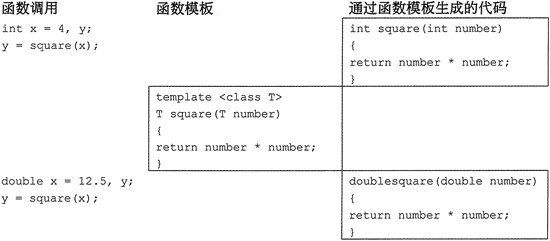C++函數模板宣告和實現
2020-07-16 10:04:43
int square(int number)
{
return number * number;
}
double square(double number)
{
return number * number;
}
這兩個函數之間的唯一區別是它們的返回值及其形參的資料型別。在這種情況下,編寫函數模板比過載函數更方便。函數模板允許程式設計師編寫一個單獨的函數定義,以處理許多不同的資料型別,而不必為每個使用的資料型別編寫單獨的函數。函數模板不是實際的函數,而是編譯器用於生成一個或多個函數的 "模具"。在編寫函數模板時,不必為形參、返回值或區域性變數指定實際型別,而是使用型別形參來指定通用資料型別。當編譯器遇到對函數的呼叫時,它將檢查其實參的資料型別,並生成將與這些資料型別配合使用的函數程式碼。
以下是一個 square 函數的函數模板:
template<class T>
T square(T number)
{
return number * number;
}
函數模板由一個模板字首標記開始,該模板字首以關鍵字 template 開始,接下來是一組尖括號,裡面包含一個或多個在模板中使用的通用資料型別。通用資料型別以關鍵字 dass 開頭,後面跟著代表資料型別的形參名稱。在上面的 square 函數模板範例中,只使用了一個名為 T 的形參(如果有更多的話,它們將用逗號分隔)。在此之後,除了使用型別形參代替實際的資料型別名稱之外,其他的都可以像往常一樣寫入函數的定義。在本函數模板範例中,以下是其函數頭:
T square(T number)
其中,T 是型別形參或通用資料型別。該函數頭定義了一個 square 函數,它返回一個 T 型別的值,並使用了一個形參 number,這也是 T 型別的數位。如前所述,編譯器會檢查對 square 的每次呼叫,並以適當的資料型別填充 T,例如,以下呼叫將使用 int 引數:
int y, x = 4;
y = square(x);
int square(int number)
{
return number * number;
}
但是,如果使用以下語句呼叫 square 函數:
double y, d = 6.2;
y = square(d);
double square(double number)
{
return number * number;
}
下面的程式演示了該函數模式的用法:// This program uses a function template.
#include <iostream>
#include <iomanip>
using namespace std;
// Template definition for square function
template <class T>
T square(T number)
{
return number * number;
}
int main()
{
cout << setprecision(5);
//Get an integer and compute its square
cout << "Enter an integer: ";
int iValue;
cin >> iValue;
// The compiler creates int square(int) at the first occurrence of a call to square with an int argument
cout << "The square is " << square(iValue);
// Get a double and compute its square
cout << "nEnter a double: ";
double dValue;
cin >> dValue;
// The compiler creates double square(double)at the first
// occurrence of a call to square with a double argument
cout << "The square is " << square (dValue) << endl;
return 0;
}
程式輸出結果:
Enter an integer: 3
The square is 9
Enter a double: 8.3
The square is 68.89

圖 1 通過函數模板生成的兩個函數範例